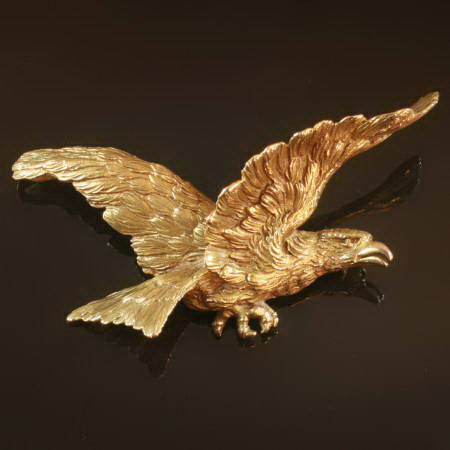Nous offrons des facilités de paiement pour le bijou de vos rêves. Demandez nous les détails. Expédition assuré gratuite !

Antique jewelry glossary
Welcome to our extensive antique jewelry glossary with around 1,500 jewelry related entries.If you feel you are missing an explanation, feel free to let us know and we will add it.
A - B - C - D - E - F - G - H - I - J - K - L - M - N - O - P - Q - R - S - T - U - V - W - X - Y - Z all
The eagle and its symbolism

See our: jewelry with eagle motifs.
The eagle symbolized strength, courage, farsightedness and immortality. It is considered to be the king of the air and the messenger of the highest Gods. Mythologically, it is connected by the Greeks with the God Zeus, by the Romans with Jupiter, by the Germanic tribes with Odin and by Christians with God.
Iranian Empires (Persia) are among the first who used eagle as a standard. To the pagans, the eagle was an emblem of Jupiter, the god of the sky. The eagle and lion of Inishowen were used as Celtic drudic holy symbols. In 102 B.C. the Roman Consul Gaius Marius decreed that the eagle would be the symbol of the Senate and People of Rome. It is said that when the Second Temple of Jerusalem was being expanded and renovated in 20 B.C., Herod the Great offended the people by mounting a Roman golden eagle over the gate. When Herod died some years later, his opponents tore down the eagle. It is believed that the Prophet Muhammad's first standard or flag in 7th century A.D. was a plain flag with no insignia on it to contradict the national standard of the opposing pagan Quraish tribe, Al-Uqaab, that had a black eagle on white background, the sacred Eagle that carried pagan prayers from Earth to the Sky.
Central Asian Turkish Shamans carried a wooden stick pole with seven or nine horizontal sticks forming stairs to an Eagle put on the top of the stick during their rituals. The eagle was regarded, for example, as a holy bird, a protective spirit, and the guardian of heaven. It was also a symbol of potency and fertility. Eagles on tombstones reflected the Shamanistic belief that the souls of the dead rose up to Heaven in the form of birds or were accompanied and protected by the eagle while traveling in the underworld and the sky. Eagle also was believed to be a carrier of prayers to the sky. The Altaic figures carved into rocks suggest that the eagle also was a sign of grandeur and magnificence among the Turks.
The Turkish shamanistic religious heritage of Asian roots survived to some extent after their acceptance of Islam and migration westwards. The metaphorical meaning of the name of Tougrul Beig (993-1063 A.D.) who founded the Seljuk State as its foremost commander was "Eagle". The spirit of the Türkmen is accepted as 'horse' in the fifth and as "eagle" in the third period.
In medieval and modern heraldry eagles are often said to indicate that the armiger (person bearing the arms) was courageous, a man of action and judicious. Where an eagle's wings were spread ("displayed") it was said to indicate the bearer's role as a protector. When mythological beasts are used, such as a griffin (part eagle, part lion) they indicate that the bearer of the arms possessed a combination of those animals' qualities.
From: Wikpedia









